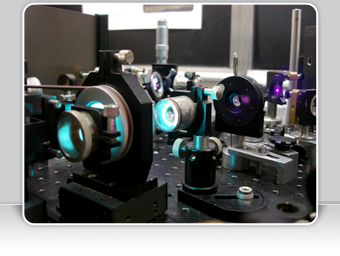« Back to all publications
Download this list in a RIS file or a BIB file or a PDF file
|
||||||||
A study of the effect of an external electric field on spectral holes burnt at different frequencies in the inhomogeneous absorption band of a centrosymmetric squaraine dye, bis [4-(diethylamino)-2-hydroxyphenyl] squaraine (DEAH), in polymers of different polarity is presented. Average matrix induced dipole moment differences of about 1 D and 0.37 D were measured in the directions parallel and perpendicular to the long axis of DEAH. In all polymers investigated, the induced dipole moment difference decreased from the higher to the lower frequencies. Solvatochromic shift measurements were performed in order to elucidate the origin of this effect. The matrix field inducing the dipole moment is also partially responsible for the frequency shift of the absorption of DEAH. With increasing matrix field, the absorptiion frequency is shifted to the blue due to electrostatic interaction with the local dipoles of DEAH. The contribution of the electrostatic interactions to the frequency shift is smaller than the dispersion interactions by two orders of magnitude in polystyrene, but increases slightly in more polar polymers. | ||||||||
|
||||||||
The free ion yield (R) resulting from the fluorescence quenching of 9,10-dicyanoanthracene (DCA) by various electron donors in acetonitrile has been studied using ns laser photoconductivity. The influence of the chemical nature of the doors is established in a general manner. For a given oxidation potential Eox(D/D+), the rate constant of geminate ion recombination, kbac, decreases significantly as the electronic delocalization of the donor increases. As a consequence multiple Marcus plots are observed in the inverted region. These plots show decreasing curvature when going from stilbenes to amines as donors. This fan effect is tentatively explained by considering the detailed roles of the parameters V, and h in the Marcus model. | ||||||||
|
||||||||
The principles of ps transient grating spectroscopy are presented. The capabilities of this technique for the study of photoinduced processes are illustrated by several new results. These include the observation of an anomalous effect in the reorientation dynamics of two ionic dyes in long-chain alkanenitriles, the measurement of the local viscosity in the interior of reverse micelles containing methanol, and the determination of the rate constant of separation of a geminate radical pair formed by photoinduced electron-transfer reaction. | ||||||||
|
||||||||
The rotational diffusion time of ruthenium (II)-bis(2,2'-bipyridine) (2,2'-biquinoleine) has been measured in polar solvents of different viscosity. The rotational dynamics can be explained in terms of the Stokes—Einstein—Debye hydrodynamics theory under stick boundary condition by considering the rotating body as a prolate spheroid enclosing the complex. This overestimates the intrinsic molecular volume by a factor of 1.5. The difference can be accounted for by solvent molecules intercalated in the interligand space and stabilized by electrostatic interaction with the charge of the metal atom. | ||||||||
|
||||||||
The rate of separation into free ions of a geminate ion pair generated by photoinduced electron transfer between 9,lO-anthraquinone excited to the lowest triplet state and 1,2,4-trimethoxybenzenein 1,1,2,2-tetrachloroethane has been measured at different temperatures by nanosecond time-resolved resonance Raman spectroscopy (TR3). The intrinsic activation energy for the separation amounts to 0.04 eV, suggesting that the center-to-center interionic distance in the geminate ion pair is about 7.5 A. The activation barrier is due to a loss of electrostatic stabilization upon separation to a distance of about 9.5 A, where a solvent molecule or part of it can interpenetrate to increase the solvation energy. This suggests that the geminate ion pair is a loose ion pair but is not truly solvent separated. | ||||||||
Download this list in a RIS file or a BIB file or a PDF file
Contact:
Eric Vauthey
Physical Chemistry Department - Sciences II - University of Geneva
30, Quai Ernest Ansermet - CH-1211 Geneva 4 (Switzerland)
© All rights reserved by Eric Vauthey and the University of Geneva
Design and code by Guillaume Duvanel




